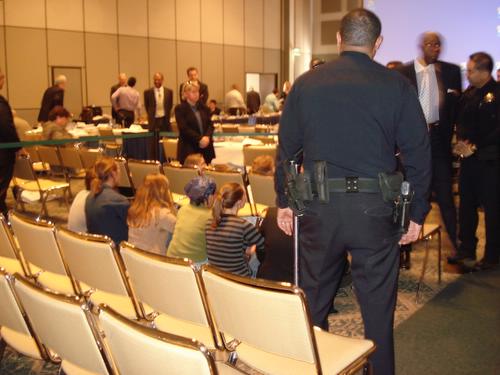Science cheerleaders shout out for global strike weapons

Trident missile launch from sea.
by Andrew Lichterman
On May 11, a National Academy of Sciences panel issued an interim letter report on equipping Trident submarine launched ballistic missiles with conventional warheads. ArmsControlWonk.com provides an easy to download copy of the report here.
Congress requested that the NAS provide an analysis of conventional Trident in the conference report accompanying the 2007 Defense Appropriations Act. A final report from the NAS committee is scheduled to be issued in 2008. The reports are not limited to the conventional Trident proposal, but will “consider and recommend alternatives that meet the prompt global strike mission in the near-, mid-, and long-term.” The NAS panel recommended that research and testing of the conventional Trident should proceed with funding levels sufficient to keep the program on course to allow deployment in three to five years. It advised against full funding for production and deployment, because other “global strike” technologies also being researched may prove more promising in the long run, and because various technical and policy issues, including the danger that a conventional Trident might be mistaken for a nuclear launch, remain unresolved.
Despite some reservations about nuclear ambiguity and the relationship of new conventional long-range systems to nuclear arsenals, the NAS panel appeared enthusiastic about pushing ahead with a new generation of strategic weapons. It endorsed further exploration of a variety of other concepts, such as a new sea-launched global strike missile design, high speed cruise missiles, and hypersonic boost glide vehicles with intercontinental range. It concluded that “[t]he committee believes it is preferable to consider all proposed CPGS weapons as elements of a portfolio, one that needs balancing in terms of technical risk and time to deployment.”
These programs, intended to yield highly accurate delivery systems with global reach for conventional weapons, are proceeding with little public debate. Further, the barriers to using improved or new non-nuclear long-range delivery systems for nuclear weapons are largely made of paper. Buried in its discussion of the danger that a conventional long-range missile might be mistaken for a nuclear one, the NAS committee acknowledges this, stating that “[i]ndeed, the ambiguity between nuclear and conventional payloads can never be totally resolved, in that any of the means for delivery of a conventional warhead could be used to deliver a nuclear warhead.” [emphasis added]
U.S. research on new strategic weapons continues apace, with advances in delivery systems and in supporting technologies used to find and track targets and to guide weapons to them appearing more significant than anything (or at least anything publicly known) happening in nuclear warhead development programs. Yet most NGO arms control and disarmament work concerning U.S. strategic weapons programs remains focused on a narrow set of nuclear weapons design and production activities. Is it more likely that there will be some development in nuclear warheads as opposed to delivery systems that affects the nuclear strategic/political calculus–including everything from the level of U.S. military commitment to nuclear weapons to the way potential adversaries view U.S. capabilities and intentions to the likelihood of nuclear weapons use–in ways that adversely affect disarmament prospects? If new, more accurate delivery systems are developed that can be paired with existing nuclear weapons (perhaps with modifications) to destroy difficult targets that the majority of Congress members (and likely still a majority) repeatedly have voted to find ways to destroy, will Congress deny the military such capabilities? Why should we believe this? I have yet to see much of a discussion of such issues in the “arms control and disarmament community,” much less their implications for disarmament strategies. But perhaps I am not looking in the right places.
These questions, however, beg even larger and more important ones. How much do the details of all of this matter? If we believe that nuclear weapons are fundamentally immoral and that a global empire ultimately underwritten by weapons with global reach is fundamentally illegitimate, why do we allow ourselves to be caught up in debates about the minutiae of one or another weapons program? These are debates that those who hold long-term power usually win even when they appear to lose, the sci-tech-military-industrial complex leviathan surging inexorably on, growing insatiably regardless of whether we knock off a barnacle or two.
“You already know enough. So do I. It is not knowledge we lack. What is missing is the courage to understand what we know and to draw conclusions.” Sven Lindqvist, “Exterminate all the Brutes”: One Man’s Odyssey into the Heart of Darkness and the Origins of European Genocide (New York: The New Press, 1996), p.2
For more on the U.S. “Prompt global strike” programs, see the preceding entry, “Next generation strategic weapons and the possibility of arms races to come.”
Trident missile launch photo from U.S. Navy, Vision… Presence… Power: A Program Guide to the U.S. Navy - 2000 Edition

